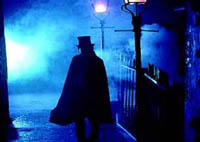Jack or Jill? The Ripper was a woman?
Everybody has heard the story of the notorious Jack the Ripper, a serial killer who murdered 5 prostitutes and The notorious serial killer who stalked London's East End, butchering prostitutes and terrorising the population, may not have been Jack the Ripper - but Jill.

An Australian scientist has used swabs from letters supposedly sent to police by the Ripper to build a partial DNA profile of the killer. The results suggest that the person who murdered and mutilated at least five women from 1888 onwards may have been a woman.
Ian Findlay, a professor of molecular and forensic diagnostics, told the Australian Broadcasting Corporation that he had developed a profiling technique that could extract DNA from a single cell or strand of hair up to 160 years old. Conventional DNA sampling methods require at least 200 cells.
Dr Findlay, who is based in Brisbane, travelled to London, where the evidence from the still-unsolved murders is stored at the National Archive. The material, which was kept by Scotland Yard until 1961, includes letters sent to police at the time, some of them signed "Jack the Ripper".
Findlay said the partial profile had been created from saliva possibly from the Ripper on the back of stamps on the envelopes of letters sent to London police.
Most of the 600 or so letters claiming to have come from the Ripper have been dismissed as hoaxes but a few are thought to be genuine, according to smh.com.au.
Dr Findlay took swabs from the back of stamps and from the gum used to seal envelopes, and possible bloodstains. He took his haul back to Brisbane, where - concentrating on swabs from the so-called "Openshaw letter", the one believed most likely to be genuine - he extracted the DNA and then amplified the information to create a profile. The resultswere "inconclusive" and not forensically reliable, but he did construct a partial profile and based on this analysis, he said, "it's possible the Ripper could be female".
The victims were all prostitutes, murdered and mutilated in the foggy alleyways of Whitechapel. By the surgical nature of the wounds, the killer was assumed to have some surgical knowledge.
The chief suspects, who included a barrister, a Polish boot-maker and a Russian confidence trickster, were all men. But Frederick Abberline, the detective who led the investigation, thought it possible the killer was a woman. This was because the fifth victim, Mary Kelly, was "seen" by witnesses hours after she was killed. Abberline thought this was the murderer running away, in Kelly's clothes.
The only female suspect was Mary Pearcey, who was convicted of murdering her lover's wife, Phoebe Hogg, in 1890 and hanged. She apparently employed a similar modus operandi to the Ripper, according to The Independent
Jack the Ripper was the name that the writer of a letter forwarded to the Metropolitan Police in September 1888 gave himself.
In it, he wrote: "I am down on whores and I shan't quite ripping them til I do get buckled."
The name Jack the Ripper caught the public imagination, and in October - after two more killings, both on the same day - police received a postcard, written in red ink by a person who called himself "saucy Jacky", according to nzherald.co.nz
Sources: agencies
Prepared by Alexander Timoshik
Prevda.ru
Subscribe to Pravda.Ru Telegram channel, Facebook, RSS!





